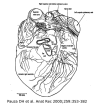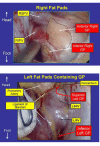The Autonomic Nervous System and Atrial Fibrillation:The Roles of Pulmonary Vein Isolation and Ganglionated Plexi Ablation
- PMID: 28496632
- PMCID: PMC5398773
- DOI: 10.4022/jafib.177
The Autonomic Nervous System and Atrial Fibrillation:The Roles of Pulmonary Vein Isolation and Ganglionated Plexi Ablation
Abstract
After the sequential successes of catheter ablation for the treatment of pre-excitation syndromes (WPW), junctional reentry (AVNRT) atrial flutter (AFL) and ventricular arrhythmias, clinical electrophysiologists have focused on the myocardial basis of atrial fibrillation (AF). Thus, the strategy for ablation of drug and cardioversion refractory AF was to isolate the myocardial connections from the focal firing pulmonary veins (PVs) in addition to altering the atrial substrate maintaining AF. However, the overall success rates have not achieved those of the other types of ablation procedures. In this review we have summarized the favorable aspects and drawbacks of pulmonary vein isolation (PVI). As for the role of the Intrinsic Cardiac Autonomic Nervous System (ICANS), both basic and clinical evidence has shown that ganglionated plexi (GP) stimulation promotes initiation and maintenance of AF, and that GP ablation reduces recurrence of AF following catheter or surgical ablation of these structures. Based on these findings, the GP Hyperactivity Hypothesis has been proposed to explain, at least in part, the mechanistic basis for the focal form of AF. For example, PV isolation may not always be necessary for elimination of AF, as in the early stages of paroxysmal AF. GP ablation alone, in these cases, may suffice for focal AF termination. In the persistent and long standing persistent forms the substrate for AF may be more extensive and therefore require GP ablation plus PV isolation and/or CFAE ablations. Clinical reports, both catheter based as well as minimally invasive surgical procedures, which include PVI plus GP ablation have shown relatively long-term success rates much closer to or equal to those achieved by myocardial ablation procedures in patients with WPW, AVNRT and AFL.
Figures








Similar articles
-
Ganglionated plexus ablation vs linear ablation in patients undergoing pulmonary vein isolation for persistent/long-standing persistent atrial fibrillation: a randomized comparison.Heart Rhythm. 2013 Sep;10(9):1280-6. doi: 10.1016/j.hrthm.2013.04.016. Epub 2013 Apr 19. Heart Rhythm. 2013. PMID: 23608592 Clinical Trial.
-
Efficacy of ganglionated plexi ablation in addition to pulmonary vein isolation for paroxysmal versus persistent atrial fibrillation: a meta-analysis of randomized controlled clinical trials.J Interv Card Electrophysiol. 2017 Dec;50(3):253-260. doi: 10.1007/s10840-017-0285-z. Epub 2017 Sep 8. J Interv Card Electrophysiol. 2017. PMID: 28887742 Review.
-
Autonomic denervation added to pulmonary vein isolation for paroxysmal atrial fibrillation: a randomized clinical trial.J Am Coll Cardiol. 2013 Dec 17;62(24):2318-25. doi: 10.1016/j.jacc.2013.06.053. Epub 2013 Aug 21. J Am Coll Cardiol. 2013. PMID: 23973694 Clinical Trial.
-
The intrinsic autonomic nervous system in atrial fibrillation: a review.ISRN Cardiol. 2012;2012:490674. doi: 10.5402/2012/490674. Epub 2012 Jun 19. ISRN Cardiol. 2012. PMID: 22778995 Free PMC article.
-
Efficacy of cardiac autonomic denervation for atrial fibrillation: a meta-analysis.J Cardiovasc Electrophysiol. 2012 Jun;23(6):592-600. doi: 10.1111/j.1540-8167.2011.02270.x. Epub 2012 Mar 19. J Cardiovasc Electrophysiol. 2012. PMID: 22429251 Review.
Cited by
-
Safety and chronic lesion characterization of pulsed field ablation in a Porcine model.J Cardiovasc Electrophysiol. 2021 Apr;32(4):958-969. doi: 10.1111/jce.14980. Epub 2021 Mar 10. J Cardiovasc Electrophysiol. 2021. PMID: 33650743 Free PMC article.
-
Association of Dexmedetomidine With New-Onset Atrial Fibrillation in Patients With Critical Illness.JAMA Netw Open. 2023 Apr 3;6(4):e239955. doi: 10.1001/jamanetworkopen.2023.9955. JAMA Netw Open. 2023. PMID: 37097632 Free PMC article.
-
Emerging Role of Renal Sympathetic Denervation as an Adjunct Therapy to Atrial Fibrillation Ablation.Rev Cardiovasc Med. 2024 Mar 28;25(4):122. doi: 10.31083/j.rcm2504122. eCollection 2024 Apr. Rev Cardiovasc Med. 2024. PMID: 39076548 Free PMC article. Review.
-
Assessment of the effect of left atrial cryoablation enhanced by ganglionated plexi ablation in the treatment of atrial fibrillation in patients undergoing open heart surgery.J Cardiothorac Surg. 2017 Aug 17;12(1):69. doi: 10.1186/s13019-017-0625-1. J Cardiothorac Surg. 2017. PMID: 28818088 Free PMC article.
-
Comparative specialization of intrinsic cardiac neurons in humans, mice, and pigs.bioRxiv [Preprint]. 2024 Apr 8:2024.04.04.588174. doi: 10.1101/2024.04.04.588174. bioRxiv. 2024. Update in: J Physiol. 2025 Mar;603(7):2043-2070. doi: 10.1113/JP286714. PMID: 38645175 Free PMC article. Updated. Preprint.
References
-
- GIRAUD G, PUECH P, LATOUR H. [The physiological electrical activity of Tawara's node and of His' bundle in man. Endocavitary electrocardiographic registration]. Bull. Acad. Natl. Med. 1960 May 10;144 ():363–6. - PubMed
-
- Scherlag B J, Lau S H, Helfant R H, Berkowitz W D, Stein E, Damato A N. Catheter technique for recording His bundle activity in man. Circulation. 1969 Jan;39 (1):13–8. - PubMed
-
- Wellens H J. Value and limitations of programmed electrical stimulation of the heart in the study and treatment of tachycardias. Circulation. 1978 May;57 (5):845–53. - PubMed
-
- Narula O S. Atrioventricular conduction defects in patients with sinus bradycardia. Analysis by His bundle recordings. Circulation. 1971 Dec;44 (6):1096–110. - PubMed
-
- Castellanos A, Castillo C, Cunha D, Myerburg R J. Value of his bundle recordings in the evaluation of the pre-excitation (Wolff-Parkinson-White) syndrome. Proc K Ned Akad Wet C. 1972;75 (5):402–21. - PubMed
Publication types
LinkOut - more resources
Full Text Sources
Other Literature Sources
Research Materials
